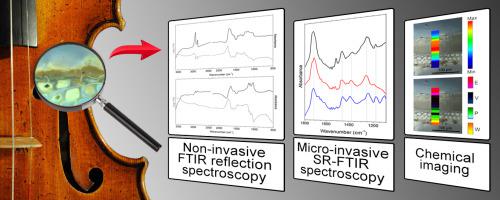Spectrochimica Acta Part A: Molecular and Biomolecular Spectroscopy ( IF 4.3 ) Pub Date : 2020-09-09 , DOI: 10.1016/j.saa.2020.118926 Giacomo Fiocco 1 , Claudia Invernizzi 2 , Silvia Grassi 3 , Patrizia Davit 4 , Michela Albano 5 , Tommaso Rovetta 6 , Chiaramaria Stani 7 , Lisa Vaccari 7 , Marco Malagodi 8 , Maurizio Licchelli 6 , Monica Gulmini 4

|
A micro-sample detached from a historical bowed string instrument represents a valuable record of the materials used by the great Masters of violin-making art. It allows researchers to collect a wealth of information and to disclose - at least partially - their procedures for finishing and varnishing.
In the present work, a set of four cross-sectioned micro-samples - collected from well-preserved bowed string instruments made by Antonio Stradivari and Lorenzo Storioni - are investigated by Synchrotron Radiation (SR) FTIR micro-spectroscopy in reflection mode. SR-FTIR spectra are discussed both as point analysis and as univariate and multivariate chemical maps. The same cross-sections are also investigated by optical microscopy under UV light and SEM-EDX. Moreover, data obtained directly from the musical instruments by a non-invasive approach employing a portable reflection FTIR spectrometer are also considered.
FTIR investigation of the cross-sections is a challenging task for such brittle and complex layered micro-samples. Nevertheless, the high intensity of the analytical SR beam used in reflection geometry allowed us to obtain informative FTIR spectra and to fully preserve the integrity of the samples.
Both the non-invasive and the micro-invasive reflection FTIR approaches can reveal the materials spread on the wood surface to finish the musical instruments. The fingerprint of Lorenzo Storioni's production around 1790 emerged from the study of the cross-sectioned samples, definitely different from the technique of Stradivari.
中文翻译:

反射FTIR光谱用于研究历史弓弦乐器:有创和无创方法。
从历史悠久的弓弦乐器上取下来的微型样品代表了伟大的提琴制作大师所使用的材料的宝贵记录。它使研究人员可以收集大量信息,并至少部分地披露其涂饰和上光步骤。
在目前的工作中,通过同步辐射(SR)FTIR显微光谱法以反射模式研究了四个横截面微样品集-从安东尼奥·斯特拉迪瓦里(Antonio Stradivari)和洛伦佐·斯托里尼(Lorenzo Storioni)制造的保存完好的弓弦乐器中收集的。SR-FTIR光谱既可以作为点分析,也可以作为单变量和多变量化学图谱进行讨论。在紫外光和SEM-EDX下,也通过光学显微镜研究了相同的横截面。而且,还考虑了通过采用便携式反射FTIR光谱仪的非侵入性方法直接从乐器获得的数据。
对于此类脆性和复杂的分层微样品,FTIR截面的研究是一项艰巨的任务。但是,反射几何中使用的高解析SR光束使我们能够获得有用的FTIR光谱并完全保留样品的完整性。
FTIR的无创和微创反射方法都可以揭示散布在木材表面上的材料,以完成乐器的制作。劳伦佐·斯托里奥尼(Lorenzo Storioni)在1790年左右生产的指纹图谱是通过对横截面样品的研究得出的,这与斯特拉迪瓦里的技术绝对不同。











































 京公网安备 11010802027423号
京公网安备 11010802027423号